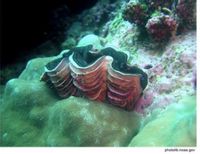
Human Anatomy & Physiology (11th Edition)
11th Edition
ISBN: 9780134580999
Author: Elaine N. Marieb, Katja N. Hoehn
Publisher: PEARSON
expand_more
expand_more
format_list_bulleted
Concept explainers
Question
What is the symmetry of this organism?
What is the life style of the organism (clam) in the photo?
|
Benthic, epifaunal |
||
|
Pelagic, nektonic |
||
|
Pelagic, planktonic |
||
|
Benthic, infaunal |
||
|
Vagrant |
||
|
Sessile |

Transcribed Image Text:This image depicts a giant clam embedded within a coral reef environment. The clam's shell is partially open, displaying wavy mantle edges with vibrant colors, which may include shades of purple, pink, or blue. The outer shell has textured ridges and a sturdy appearance, characteristic of giant clams.
The reef structure around the clam consists of various corals, providing a rich habitat for marine life. The different coral textures and colors contribute to the biodiversity and complexity of the reef ecosystem. This setting highlights the symbiotic relationship between clams and the coral reef, where the clam benefits from sunlight exposure and nutrient exchange.
The photo credit is given as "photolib.noaa.gov," indicating that the image originates from a source focusing on oceanic and atmospheric research.
Expert Solution
This question has been solved!
Explore an expertly crafted, step-by-step solution for a thorough understanding of key concepts.
This is a popular solution
Trending nowThis is a popular solution!
Step by stepSolved in 2 steps

Knowledge Booster
Learn more about
Need a deep-dive on the concept behind this application? Look no further. Learn more about this topic, biology and related others by exploring similar questions and additional content below.Similar questions
- In an Obelia colony, which of the following absorb more stain than others? Gonangiun, Perisarc, Coenosarc, Polyp Tentacles Note: In your answer list them in order from darkest to lightest staining.arrow_forwardIn order to flip themselves upright, horseshoe crabs use their: Chelipids Telson Gnathobases Spatula Uropodsarrow_forwardWhich of the following statements regarding the anthozoans is false? They have symbiotic algae living in their tissues They are restricted to comparatively shallow waters They are the reef building corals They spend most of their life in the medusa body formarrow_forward
- What is it about some protistans that we refer to them as “protozoans”? Group of answer choices They are multicellular they capture smaller organisms as prey They are all genetically linked to animals they are large 10arrow_forwardMost bivalves can be classified as filter feeders. Indicate the parts/cell type of the sponge that is analogous to the bivalve structures in the table below.arrow_forwardPorifera Sponge What is the color of the sponge, size, surface texture, whether it is solid or hollow and what is the cycle attributes, its ecology and ecnomic usesarrow_forward
arrow_back_ios
arrow_forward_ios
Recommended textbooks for you
 Human Anatomy & Physiology (11th Edition)BiologyISBN:9780134580999Author:Elaine N. Marieb, Katja N. HoehnPublisher:PEARSON
Human Anatomy & Physiology (11th Edition)BiologyISBN:9780134580999Author:Elaine N. Marieb, Katja N. HoehnPublisher:PEARSON Biology 2eBiologyISBN:9781947172517Author:Matthew Douglas, Jung Choi, Mary Ann ClarkPublisher:OpenStax
Biology 2eBiologyISBN:9781947172517Author:Matthew Douglas, Jung Choi, Mary Ann ClarkPublisher:OpenStax Anatomy & PhysiologyBiologyISBN:9781259398629Author:McKinley, Michael P., O'loughlin, Valerie Dean, Bidle, Theresa StouterPublisher:Mcgraw Hill Education,
Anatomy & PhysiologyBiologyISBN:9781259398629Author:McKinley, Michael P., O'loughlin, Valerie Dean, Bidle, Theresa StouterPublisher:Mcgraw Hill Education, Molecular Biology of the Cell (Sixth Edition)BiologyISBN:9780815344322Author:Bruce Alberts, Alexander D. Johnson, Julian Lewis, David Morgan, Martin Raff, Keith Roberts, Peter WalterPublisher:W. W. Norton & Company
Molecular Biology of the Cell (Sixth Edition)BiologyISBN:9780815344322Author:Bruce Alberts, Alexander D. Johnson, Julian Lewis, David Morgan, Martin Raff, Keith Roberts, Peter WalterPublisher:W. W. Norton & Company Laboratory Manual For Human Anatomy & PhysiologyBiologyISBN:9781260159363Author:Martin, Terry R., Prentice-craver, CynthiaPublisher:McGraw-Hill Publishing Co.
Laboratory Manual For Human Anatomy & PhysiologyBiologyISBN:9781260159363Author:Martin, Terry R., Prentice-craver, CynthiaPublisher:McGraw-Hill Publishing Co. Inquiry Into Life (16th Edition)BiologyISBN:9781260231700Author:Sylvia S. Mader, Michael WindelspechtPublisher:McGraw Hill Education
Inquiry Into Life (16th Edition)BiologyISBN:9781260231700Author:Sylvia S. Mader, Michael WindelspechtPublisher:McGraw Hill Education

Human Anatomy & Physiology (11th Edition)
Biology
ISBN:9780134580999
Author:Elaine N. Marieb, Katja N. Hoehn
Publisher:PEARSON

Biology 2e
Biology
ISBN:9781947172517
Author:Matthew Douglas, Jung Choi, Mary Ann Clark
Publisher:OpenStax

Anatomy & Physiology
Biology
ISBN:9781259398629
Author:McKinley, Michael P., O'loughlin, Valerie Dean, Bidle, Theresa Stouter
Publisher:Mcgraw Hill Education,

Molecular Biology of the Cell (Sixth Edition)
Biology
ISBN:9780815344322
Author:Bruce Alberts, Alexander D. Johnson, Julian Lewis, David Morgan, Martin Raff, Keith Roberts, Peter Walter
Publisher:W. W. Norton & Company

Laboratory Manual For Human Anatomy & Physiology
Biology
ISBN:9781260159363
Author:Martin, Terry R., Prentice-craver, Cynthia
Publisher:McGraw-Hill Publishing Co.

Inquiry Into Life (16th Edition)
Biology
ISBN:9781260231700
Author:Sylvia S. Mader, Michael Windelspecht
Publisher:McGraw Hill Education